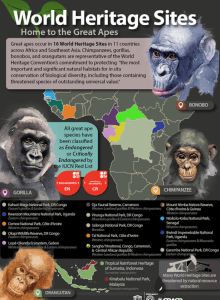TAG: GS 3: ECOLOGY AND ENVIRONMENT
THE CONTEXT: A recent study published in the journal Science Advances has shed light on the alarming threat posed by mining activities to Africa’s great apes.
EXPLANATION:
- It was led by researchers from the German Centre for Integrative Biodiversity Research and Martin Luther University Halle-Wittenberg, in collaboration with the conservation organization Re:wild.
- The study underscores the significant risk faced by gorillas, chimpanzees, bonobos, and orangutans due to mining operations across the continent.
Extent of Threat
- The study reveals that nearly 180,000 individuals, representing more than a third of Africa’s great ape population, are either directly or indirectly threatened by mining activities, both currently and in the foreseeable future.
- The intersection of mining areas with critical habitats, crucial for the biodiversity of these species, is particularly concerning, with approximately 20% of mining areas overlapping with such habitats.
Regional Disparities
- West Africa emerges as a region of heightened concern, with up to 82% of the great ape population residing near operational or pre-operational mining sites.
- Countries like Liberia, Sierra Leone, Mali, and Guinea are identified as particularly vulnerable, with high proportional overlaps between ape population abundance and mining areas.
- For instance, in Guinea, over 23,000 chimpanzees could be impacted, potentially affecting up to 83% of the country’s ape population.
Drivers of Threat
- The study highlights the burgeoning demand for critical minerals, essential for clean energy transitions, as a key driver behind the mining boom in Africa.
- This demand incentivizes the exploitation of untapped resources, leading to deforestation and habitat destruction in great ape habitats.
- Additionally, inadequate protection of sensitive areas, characterized by high ape and mining densities, exacerbates the threat faced by these species.
Methodology and Findings
- Researchers employed primates as a case study to quantify the impact of industrial mining on wildlife populations, establishing 10-kilometer buffer zones around mining sites to account for direct impacts such as habitat destruction, as well as indirect impacts like light and noise pollution.
- The study’s findings underscore the significant negative impact of mining activities on ape populations in and around operational and pre-operational mining sites across 17 African countries.
Implications for Conservation
- The study underscores the urgent need for enhanced conservation efforts to protect Africa’s great apes from the detrimental effects of mining activities.
- Strengthening environmental regulations and ensuring compliance with international standards, particularly in regions with high ape and mining densities, is imperative.
- Moreover, proactive measures to mitigate habitat loss and fragmentation, coupled with sustainable mining practices, are essential to safeguarding the long-term survival of these iconic species amidst increasing anthropogenic pressures.
Great Apes:
- The gorilla, chimpanzee, bonobo, and orangutan are called great apes in recognition of their comparatively large size and humanlike features; the gibbons are called lesser apes.
- The great apes are much more intelligent than monkeys and gibbons. Great apes, for example, are able to recognize themselves in mirrors (monkeys and other nonhumans cannot, with the exception of bottlenose dolphins).
- They can also reason abstractly, learn quasi-linguistic communication, at least when taught by humans, and learn in captivity to make simple tools (though some populations of orangutans and chimpanzees make tools in the wild).
- The great apes were formerly classified in their own family, Pongidae, but, because of their extremely close relation to humans and the fact that orangutans, gorillas, and chimpanzees are not as closely related to each other as chimpanzees are to humans, all are now grouped with humans in the family Hominidae.
- Within this family, gorillas, chimpanzees, and humans make up the subfamily Homininae, while orangutans are placed in their own subfamily, Ponginae. Within Homininae, humans are often placed in their own “tribe,” Hominini.
- Also placed in distinct tribes are gorillas (tribe Gorillini) and chimpanzees (tribe Panini).
- All nonhuman apes have been classified as endangered species.

Great apes
Spread the Word
